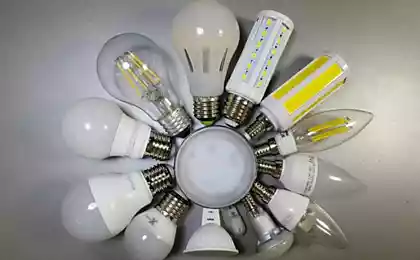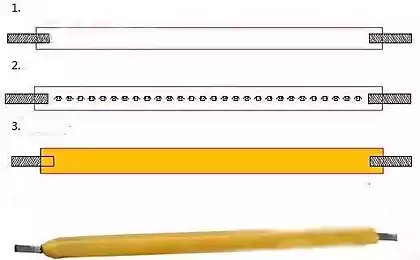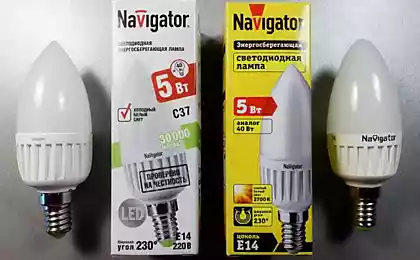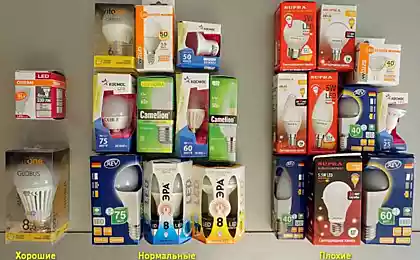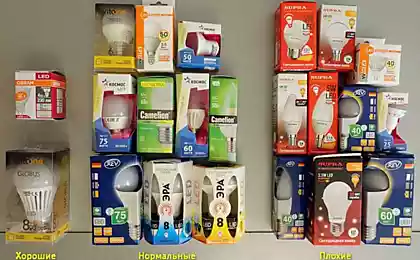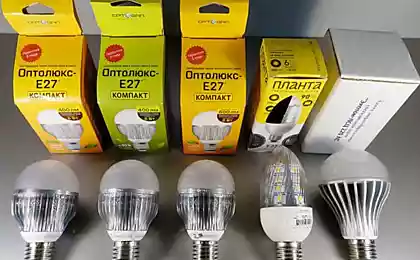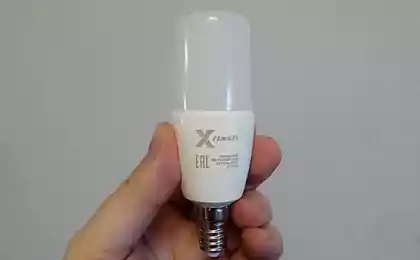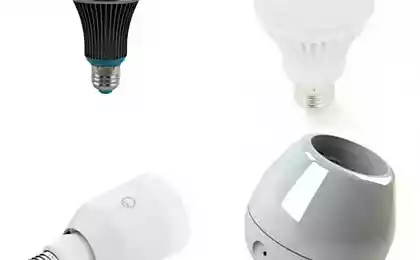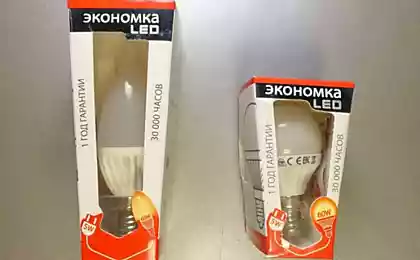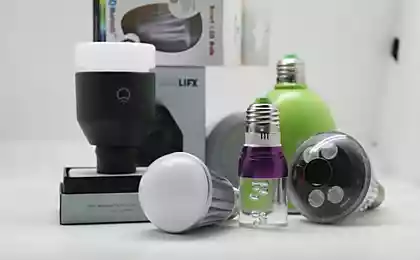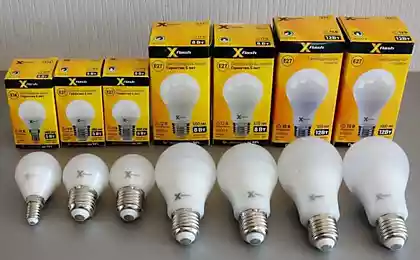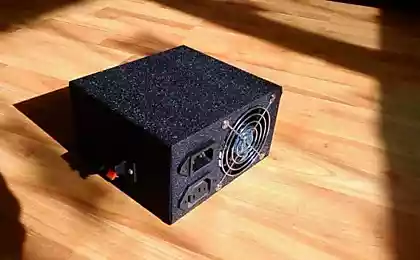2170
Saga of the LED lamps. Part 2 - about what is not written on the boxes
In last time we briefly recall the history of artificial lighting, and talked a little bit about what the basic parameters have energy-saving lamps and LED general lamps in particular. Today, as promised, we turn to measurement and comparison (but so far without unwinding).
And is it worth it? H4> First of all I was worried about the obvious question - yet so incredibly effective if conventional LED bulbs, which can be bought in a shop in the real world? To answer this question, I decided to measure the illumination created in my room different bulbs screwed into the same (my) chandelier. Initially there were three dvadtsativattnyh CFL abbr> «Era"; For comparison, I took the three LED lamps Gauss at 12 W (stating that it is an analog of 100 watts of incandescent bulbs) and, for the purity of the experiment, three conventional incandescent bulbs by 95 watts. Measurements were carried out in the center of the room, that is exactly where the lighting to me the most interesting and necessary. I have to say - in terms of photometry is probably not entirely correct; but from the point of view of ordinary life such a comparison, I think, is of major interest, since it reflects the behavior of the light bulb is not in the integrating sphere, and in the most ordinary chandelier.
Bulb Type The measured power, W (cold start) cos (φ) K p < / sub> In general ASD 11W 9 0.82 1% Very good Gauss 12 W 12 0.62 < 1% Good Gauss 6.5 W 6 0.50 < 1% Acceptable SUPRA 11 W 9 0.95 < 35% Bad ASD 7 W 4 0.45 < 100% Disgusting
with base E14:
Bulb Type The measured power, W (cold start) cos (φ) K p < / sub> In general Gauss 3W 2 0.60 1% Good Gauss 6.5W 6 0.95 49% Very bad Wolta 5W 2.2 0.40 68% Disgusting
About the lamp Wolta should talk separately The packaging proud inscription reads:
"Optimal eye flicker frequency." To get! What is there for such a frequency? Maybe they mean that it is far beyond the regulated health regulations three hundred Hertz?
Seen on the oscilloscope:
100 Hz, the ripple factor of 68%. By SanPin fails. What they mean by Optimal - conundrum ...
As we see here in LED bulbs are not all that bright. Immediately turns out a very interesting fact - it seems that the quality of LED lamps can not be judged only by the manufacturer; the same brands, in general, pose as quality records and antirecord. It should be noted that the general verdict, presented in Table I endured, giving more importance ripple than the power factor, for the reasons stated above. But even the ripple factor of 1% can not quite justify the power factor of 0.5, in the case of industrial products, sold millions of copies. However, the house is better to take a lamp than a product with unity power factor and ripple 50%.
Of course, the lamp by a factor of more than 20% ripple categorically not suitable for general lighting (chandelier in six pieces so you should not twist). By the way, I mentioned to CFL "Era" it is a little less than 10%, and for the classical bulb - about 13%.
The last parameter, which can be casual talk, it's the color temperature and color rendering index. Despite the fact that they are formalized, at the household level, it comes down to "like / dislike". I must say that all the tested lamps in this plan have pleased me - none there was no obvious bias in the blue or excessive yellowness, all had a nice white color. But this, of course, to my taste, and only.
In future articles, we will finally see what bulbs inside, and try to understand what internal reasons make good bulbs good and bad - bad.
Note: h4> The choice of lamps for test driven solely by considerations of "what happened." If (when) there will be other lamps - Gaugeable and lay out.
And is it worth it? H4> First of all I was worried about the obvious question - yet so incredibly effective if conventional LED bulbs, which can be bought in a shop in the real world? To answer this question, I decided to measure the illumination created in my room different bulbs screwed into the same (my) chandelier. Initially there were three dvadtsativattnyh CFL abbr> «Era"; For comparison, I took the three LED lamps Gauss at 12 W (stating that it is an analog of 100 watts of incandescent bulbs) and, for the purity of the experiment, three conventional incandescent bulbs by 95 watts. Measurements were carried out in the center of the room, that is exactly where the lighting to me the most interesting and necessary. I have to say - in terms of photometry is probably not entirely correct; but from the point of view of ordinary life such a comparison, I think, is of major interest, since it reflects the behavior of the light bulb is not in the integrating sphere, and in the most ordinary chandelier.
The measurements were made of the light meter Mastech MS6610 . Parties flare I excluded blackout curtains (with the light off the instrument indicates zero lux). Since the light output of fluorescent and LED lamps depends on the temperature, irradiance values were recorded twice - immediately after the start and after a ten-minute warm-up (empirically it was found that after ten minutes of illumination varies very slightly). Incandescent lamps, of course, it is not necessary to warm up, so for them the measurement was performed only once, immediately after the order not to spoil the chandelier, calculated, if my memory serves me, a maximum of 40 Watts (for incandescent bulbs) in each cone. The results of this experiment can be seen in the table below.
| Bulb Type | Status | Light metering suite |
| CFL "Era" 20 W 2700 K | cold start | 30 |
| warmed | 131 | |
| Incandescent 95 W | - | 101 |
| Lamp «Gauss LED» 2700 K 12 W < / | cold start | 146 |
| warmed | 137 table > Well, it is evident that this test LED lamps (at least those that were with me) really surpass all that now can be screwed into a regular cartridge E27 (except, perhaps, some exotics). With bulb is clear - and so I guessed that the result will not be too impressive. Interesting to compare the LED lamps and CFLs are still popular. Immediately evident that in the first ten minutes of CFL change the brightness by almost five times. In practice, this means that the domestic scenario, "entered the room (closet) for two minutes to find something" they fit worse of all - by the time the working mode of their likely already turned off. This is in addition to gas-discharge lamps, and so can not tolerate frequent switching, though, will put in the closet, they may be less frequent, but, nevertheless, of short duration. LED lamp, contrary, several lower brightness as heating - the voltage drop and therefore the power (constant current) for the LED is heated less. Nevertheless, the difference in brightness is not wearing a stunning nature as in the case of CFL (which indirectly indicates relatively good heat dissipation particularly in those lamps). By the way, it is seen that after heating and the difference is still in favor of LEDs, although its size is such that we can assume illumination created and those and others, are approximately equal. However, we are talking about approximately equal illumination created dvadtsativattnoy dvenadtsativattnoy CFL and LED-lamps - saving power almost doubled. About incandescent bulbs can not even talk - with many times more power consumption generated illumination they lose and CFLs and LEDs. Also, as I mentioned above, in my devyanostopyativattnye lamp chandelier screwed at all impossible, so in reality with incandescent I would not get even a hundred of these suites. Of course, this limitation is due to the heating. Incandescent lamps, obviously, already out of the race, so let's compare the CFL and LED lamps on the heating. These pictures were taken after a ten-minute warm-up. It is seen that CFL heated to one hundred degrees or more, while the maximum temperature of the LED lamp is only about sixty. That is, the ability to burn yourself on the CFL, in principle, there is a (protein starts to fold at eighty degrees Celsius), while the LED lamp is impossible in principle. A trifle, but nice. More measurements h4> So, we figured out that from the point of view of those characteristics that come to mind first, LEDs clearly better. Time to talk about the finer matter, such as power factor and ripple factor. About these hakteristikah somehow remember all rare and, of course, their (yet?) Have never written on the packages, but in vain. |
with base E14:
Bulb Type The measured power, W (cold start) cos (φ) K p < / sub> In general Gauss 3W 2 0.60 1% Good Gauss 6.5W 6 0.95 49% Very bad Wolta 5W 2.2 0.40 68% Disgusting
About the lamp Wolta should talk separately The packaging proud inscription reads:
"Optimal eye flicker frequency." To get! What is there for such a frequency? Maybe they mean that it is far beyond the regulated health regulations three hundred Hertz?
Seen on the oscilloscope:
100 Hz, the ripple factor of 68%. By SanPin fails. What they mean by Optimal - conundrum ...
As we see here in LED bulbs are not all that bright. Immediately turns out a very interesting fact - it seems that the quality of LED lamps can not be judged only by the manufacturer; the same brands, in general, pose as quality records and antirecord. It should be noted that the general verdict, presented in Table I endured, giving more importance ripple than the power factor, for the reasons stated above. But even the ripple factor of 1% can not quite justify the power factor of 0.5, in the case of industrial products, sold millions of copies. However, the house is better to take a lamp than a product with unity power factor and ripple 50%.
Of course, the lamp by a factor of more than 20% ripple categorically not suitable for general lighting (chandelier in six pieces so you should not twist). By the way, I mentioned to CFL "Era" it is a little less than 10%, and for the classical bulb - about 13%.
The last parameter, which can be casual talk, it's the color temperature and color rendering index. Despite the fact that they are formalized, at the household level, it comes down to "like / dislike". I must say that all the tested lamps in this plan have pleased me - none there was no obvious bias in the blue or excessive yellowness, all had a nice white color. But this, of course, to my taste, and only.
In future articles, we will finally see what bulbs inside, and try to understand what internal reasons make good bulbs good and bad - bad.
